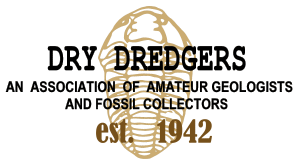No, this isn’t a question on a TV game show.
The beast I refer to falls into the category of echinoderms. And for this recently found Silurian cystoid specimen, I’m hoping someone can provide an answer to What’s my genus?
On yet another one of my many trips to the Silurian Massie (formerly Osgood) Shale of Southeast Indiana, I collected a partial cystoid that appears to be different from anything I’ve found previously at the site (a commercial rock quarry). So, even after multiple trips per year over the past 37 years, there are still new surprises!
The bulbous theca (body) has a relatively smooth surface, with several rows of small elongated hexagonal plates (see Figure 1). The oral area (see Figure 2) has 5 brachiole (“arm”) attachment sites arranged around an oral opening that has a pentagonal shape — that is typical for many of the cystoid genera found at this locality.

Figure 1. Side view of unidentified cystoid from the Silurian Massie Shale of SE Indiana. Note the rows of elongated small hexagonal plates. Specimen is 1.5 inches tall.

Figure 2. Top view of unidentified cystoid. The red arrows indicate the 5 brachiole attachment sites.
The bulbous appearance and smoothness are reminiscent of Trematocystis (see Figure 3), but the thecal plates of Trematocystis are fewer in number and relatively larger. And this genus has a square oral area with only 4 brachiole attachment sites (see Figure 4). Also, Trematocystis has long radiating ambulacrals, which the new guy does not.

Figure 3. Side view of Trematocystis theca. Note the relatively large hexagonal plates. Specimen is 1.25 inches tall.
The new guy also does not look like the cylindrical Holocystites species. These species also have rows of elongated hexagonal plates and a pentagonal oral area, but the theca is shaped more like a cigar. And its thecal plates are relatively much larger and fewer in number (see Figure 5).

Figure 5. Side view of cylindrical Holocystites. Note the relatively large hexagonal plates. Specimen is 2.5 inches long.
So, the new guy is a bit of a mystery. And a rare beast considering how many times I’ve collected the Massie Shale without previously finding one.
Too bad this specimen is not more complete: the base is gone, and the side of the theca not shown in Figure 1 is largely missing, as is half of the anal opening. Looks like it was hit by heavy equipment during quarry operations. But still a reasonably decent specimen — should be enough to determine if it’s a described genus.
My conclusion is that it might be Pentacystis, an eroded incomplete specimen of which is illustrated by Frest et al. in a study that encompassed material collected decades ago from the same Massie locality in Indiana. [Reference: Frest, Strimple and Paul, The North American Holocystites fauna (echinodermata: blastozoa: diploporita): paleobiology and systematics, Bulletins of American Paleontology, Number 380, March 2011, p. 132, Plate 12].
Does it look like anything you’re seen? If so, please comment on this blog post with your thoughts.
Thanks.
Don
Don Bissett

A long-time member of the Dry Dredgers, I’ve been collecting fossils ever since moving to Cincinnati in 1975 to work at P&G. I was introduced to fossil collecting by Bruce Gibson, another Dry Dredger and co-worker at P&G. Shortly after that, I met Dredger Dan Cooper. Both of them taught me a lot about the hobby. Ever since, I’ve been hooked on fossils.
My primary focus is collecting trilobites and echinoderms, though I often find myself accumulating a much wider assortment of fossils. Beyond the collecting hobby, I’ve also had the opportunity to work with professional paleontologists – extremely rewarding experiences. Some of those have been described in Dry Dredger Bulletin articles, MAPS (Mid-American Paleontology Society) articles, and technical publications. I plan to share more about collecting and professional interactions in my blog posts.Latest posts by Don Bissett (see all)
- Massie Shale Calymene - January 4, 2021
- Mississippian starfish - November 13, 2020
- Walcott-Rust Starfish - October 25, 2020
- Spathacalymene - September 20, 2020
- Penn Dixie Dig with the Experts 2018 - May 27, 2018





